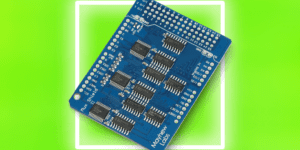Science is a great tool by which we can get to know and understand how the world around us works in terms of nature and artificial human impact. One of the most popular technical sciences is electronics, which is derived from mathematics, physics and electrical engineering.
The main fields of electronics concern issues related to the generation and processing of electrical signals, primarily with the use of semiconductor devices. The beginnings of electronics were initiated by several important achievements in the field of scientific discoveries and inventions, i.e. vacuum tubes (1904), p-n junction (1939), first transistor prototype (1947), and let’s not forget about Czochralski monocrystalline silicon method (1918), which is the fundamental process used to this day as most important part of semiconductor manufacturing – including microprocessors.
Nowadays, electronics is a part of almost every part of the world around us. Hence, more and more companies in the labor market need to hire more and more professionals in the field of electronics. For this reason, technical schools and colleges put more and more emphasis on electronics teaching, but it is only raw knowledge that should be developed as much as possible – let’s find out how to properly do it by yourself!
Hardware practice
First of all, it’s best to learn anything on your own through hands-on exercises. Although electronics is a fascinating field, a wide theoretical knowledge on this subject will not make you know everything about designing, building and repairing electronic circuits. The theoretical fundamentals are of course indispensable (e.g. knowledge of basic physical quantities and the principle of operation of basic electronic components) and it is good to understand them at the very beginning of your adventure with electronics. If you have problems with the assembly and commissioning of electronic circuits at the beginning, don’t worry much about it. The more you practice, the more you will know and understand how the electronics devices work!

Theory – don’t throw it away!
Learning electronics without a practical approach can be useless. Of course, practical exercises are the best way to learn but to better understand why the transistor starts to conduct when you put the voltage to its base or why the capacitor blocks the DC current in steady-state, you’ll need a little bit of theoretical preparation. The whole internet is full of extensive tutorials that illustrate how to connect electrical circuits step-by-step and describe their operation using simple mathematical calculations. In addition, it is worth exploring the knowledge of electronics from books, including those that were published several dozen years ago. One of the recommended books for beginners is Cathleen Shamieh’s “Electronics For Dummies”, which is written in an easy-to-understand language without over-using purely engineering terminology. Knowing how to calculate the required values of components for your circuit will be much easier for you.
Hey, not so fast
When you get started with electronics, do not take a remote-controlled robot or a D-class audio amplifier as your first project. It might be too hard, but you’ll learn this later eventually. When asking about where you should start, learn the most fundamental basics at first. You should begin with simple few-elements circuits on a solderless breadboard, such as a tact switch-controlled LED diode, then BJT transistors, operational amplifiers and then logic circuits, which will help you to understand how to use microcontrollers in terms of hardware and software.
Basic equipment
The best solution to start learning electronics is to buy a starter kit that contains electronic components (such as starter kits available at the Botland Store). Besides kits for strict educational purposes, you can also buy a specific device kit such as LED level meter, clap switch or guitar fuzz pedal. Sounds little too specific? Well, that depends what would you like to consider at first. The individual components of such kit are pretty simple and match a beginner’s approach. When assembling the kit, you are practicing soldering, which is very useful on an electronics daily basis. If the device you’ve built doesn’t work on the first run, don’t give up. At this point you’ll realize that the important part of electronics is also perfecting the flaws in diagnosing and repairing skills.
How useful was this post?
Click on a star to rate it!
Average rating 0 / 5. Vote count: 0
No votes so far! Be the first to rate this post.






